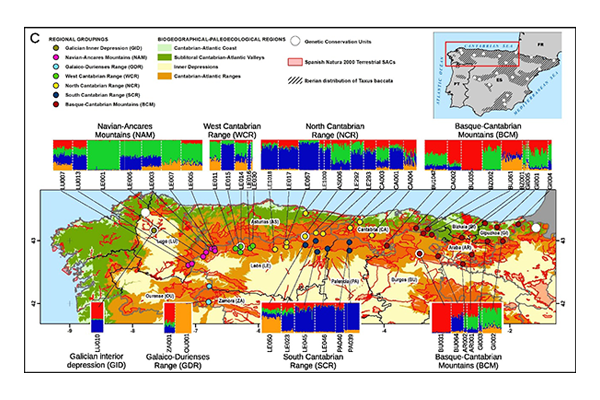LIFE BACCATA publishes an international impact article about the genetic diversity of yew in the Cantabrian-Atlantic mountains
12-03-2021

As a result of the work to collect more than 1,000 yew samples from 49 localities distributed in 30 ZECs of the Natura 2000 Network of the North of the Iberian Peninsula, and the subsequent analysis of 9 microsatellite DNA markers (SSR) using PCR techniques and automatic sequencer, it has been possible to determine the genetic diversity and the degree of kinship of the yew populations of the Cantabrian-Atlantic mountains, as we explained in the project's Special Newsletter No. 3 (August 2020).
The information obtained and the knowledge generated have been so relevant that they have led the LIFE BACCATA team to prepare an article in which the methodology used is collected, the procedure followed is detailed, and the results obtained and the conclusions derived from them are presented to the scientific community. The relevance of the LIFE BACCATA data has been so high that its validity has not only transcended at a Cantabrian Mountains level, but the information has been contrasted with previous works on the genetic characterization of yew at Spanish level, provided by the Center for Ecological Research and Forestry Applications (CREAF), allowing to broaden the contextualization of the project results. The article, entitled “Genetic diversity and structure of Taxus baccata from the Cantabrian-Atlantic area in northern Spain: A guide for conservation and management actions”, has been published in Volume 482 of Forest Ecology and Management, a prestigious journal in the forestry field.
The results of the extensive sampling carried out confirm a high diversity of yew genetic resources in the Cantabrian-Atlantic mountains, representing an important source of genetic variation of the species. Some populations showed high genetic variability and low kinship, signs of a larger population size and connectivity throughout the LIFE BACCATA area. The analysis of genetic clustering between populations showed evidence of structuring at different spatial scales, probably associated with the combination of effects of climatic fluctuations from the historical past with a more recent human impact. On a global scale, a differentiation of the easternmost samples was observed, with signs of greater historical connectivity in the western areas. On a regional scale, genetic differences were identified between 7 biogeographic groups, associated with processes of change and dispersal in the evolutionary history of the species. At a finer scale, an important component of local structuring was detected, reflecting low connectivity between populations, characteristic of southern ranges of the species.
The genetic data obtained have provided information and criteria as a basis to guide the conservation actions of LIFE BACCATA, both in situ (mainly reinforcement / planting / translocation in their natural habitat) and ex situ (for example, seed and clonal banks).


The information obtained and the knowledge generated have been so relevant that they have led the LIFE BACCATA team to prepare an article in which the methodology used is collected, the procedure followed is detailed, and the results obtained and the conclusions derived from them are presented to the scientific community. The relevance of the LIFE BACCATA data has been so high that its validity has not only transcended at a Cantabrian Mountains level, but the information has been contrasted with previous works on the genetic characterization of yew at Spanish level, provided by the Center for Ecological Research and Forestry Applications (CREAF), allowing to broaden the contextualization of the project results. The article, entitled “Genetic diversity and structure of Taxus baccata from the Cantabrian-Atlantic area in northern Spain: A guide for conservation and management actions”, has been published in Volume 482 of Forest Ecology and Management, a prestigious journal in the forestry field.
The results of the extensive sampling carried out confirm a high diversity of yew genetic resources in the Cantabrian-Atlantic mountains, representing an important source of genetic variation of the species. Some populations showed high genetic variability and low kinship, signs of a larger population size and connectivity throughout the LIFE BACCATA area. The analysis of genetic clustering between populations showed evidence of structuring at different spatial scales, probably associated with the combination of effects of climatic fluctuations from the historical past with a more recent human impact. On a global scale, a differentiation of the easternmost samples was observed, with signs of greater historical connectivity in the western areas. On a regional scale, genetic differences were identified between 7 biogeographic groups, associated with processes of change and dispersal in the evolutionary history of the species. At a finer scale, an important component of local structuring was detected, reflecting low connectivity between populations, characteristic of southern ranges of the species.
The genetic data obtained have provided information and criteria as a basis to guide the conservation actions of LIFE BACCATA, both in situ (mainly reinforcement / planting / translocation in their natural habitat) and ex situ (for example, seed and clonal banks).





